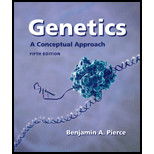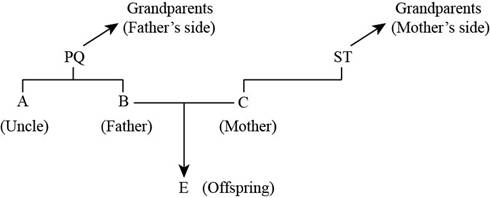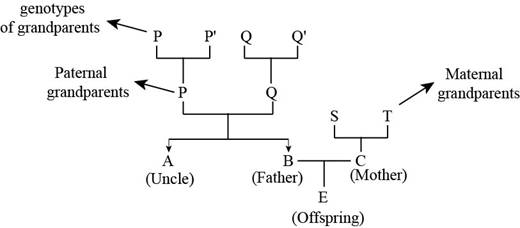
a.
To determine:
The proportion of genome between child and father that would be exactly the same, if no crossing over took place.
Introduction:
Crossing over refers to the exchange of genes between 2 chromosomes that results n chromatids that are non-identical and which comprises of the gametic (eggs or sperms) genetic material. Crossing over occurs at the time of Meiosis stage of prophase I and hence, the chromosomes are duplicated after swapping of genes.
a.
Explanation of Solution
In the given case, let P and Q be alleles of a single gene. Now,
From the given cross it can be said that there is only 50% transfer of alleles from the father and 50% transfer of alleles from the mother to the offsprings. Hence, exactly 50% alleles will be transferred to the child from father.
b.
To determine:
The proportion of genome between the child and mother that would be exactly the same, if no crossing over took place.
Introduction:
Crossing over refers to the exchange of genes between 2 chromosomes that results n chromatids that are non-identical and which comprises of the gametic (eggs or sperms) genetic material. Crossing over occurs at the time of Meiosis stage of prophase I and hence, the chromosomes are duplicated after swapping of genes.
b.
Explanation of Solution
In the given case, let P and Q be alleles of a single gene. Now,
From the given cross it can be said that there is only 50% transfer of alleles from the father and 50% transfer of alleles from the mother to the offspring’s. Hence, exactly 50% alleles will be transferred to the child from mother.
c.
To determine:
The proportion of genome of the two full siblings (having same two biological parents) that would be exactly the same if no crossing over took place.
Introduction:
Crossing over refers to the exchange of genes between 2 chromosomes that results n chromatids that are non-identical and which comprises of the gametic (eggs or sperms) genetic material. Crossing over occurs at the time of Meiosis stage of prophase I and hence, the chromosomes are duplicated after swapping of genes.
c.
Explanation of Solution
Here, suppose P and Q are the parents. Suppose A and B are the full siblings of these (P and Q) parents. Now, the gametes of P would be P and
Hence, there are 4 possible offsprings that can be produced from both the parents. Now, as there are two siblings, the sibling A’s probability of having the genotype PQ is one-fourth,
Case I: Now, if the genome of the siblings will be 100% identical, then the genotypes in both the sibling’s would be:
Hence, 4 possible cases can be possible in 100% identity.
Case II: Now, if the genome of the siblings will be 50% identical, then the genotypes in both the sibling’s would be:
Hence, there are 8 possible cases with 50% identity.
Case III: Now, if the genome of the siblings will be 0% identical, then the genotypes in both the sibling’s would be:
Hence, there are 4 possible cases with 0% identity.
Now, the total number of average genome that can be same between both the siblings should be calculated. The total progenies are 16 (all progenies of the 3 cases). Thus, the percentage of genome that is same between both the siblings can be calculated as follows:
Hence, the percentage of same genome in case of the two full sibling’s will be
d.
To determine:
The proportion of genome of the half siblings (having same two biological parents) that would be exactly the same if no crossing over took place.
Introduction:
Crossing over refers to the exchange of genes between 2 chromosomes that results n chromatids that are non-identical and which comprises of the gametic (eggs or sperms) genetic material. Crossing over occurs at the time of Meiosis stage of prophase I and hence, the chromosomes are duplicated after swapping of genes.
d.
Explanation of Solution
As P and Q are the parents (old) and let P and R are the new parents. Here, P is common between both the parents and thus, they would produce offsprings that would have only one parent in common biologically. The offsprings are A and S. The gametes of the parent P are
Similarly, the progenies of P and R are:
Now, the offsprings A and S will be inheriting half of their genotypes from the parent P and half from the parent R.
Case I: Now, if the genome of the siblings will be 50% identical, then the genotypes in both the sibling’s would be:
Hence, 8 possible cases can be possible in 50% identity.
Case II: Now, if the genome of the siblings will be 0% identical, then the genotypes in both the sibling’s would be:
Hence, there are 8 possible cases with 0% identity.
Now, the total number of average genome that can be same between half of the siblings should be calculated. The total progenies are 16 (all progenies of both the cases). Thus, the percentage of genome that is same between half of the siblings can be calculated as follows:
Hence, the percentage of same genome in case of half sibling’s will be
e.
To determine:
The proportion of genome between uncle and niece that would be exactly the same, if no crossing over took place.
Introduction:
Crossing over refers to the exchange of genes between 2 chromosomes that results n chromatids that are non-identical and which comprises of the gametic (eggs or sperms) genetic material. Crossing over occurs at the time of Meiosis stage of prophase I and hence, the chromosomes are duplicated after swapping of genes.
e.
Explanation of Solution
Pictorial representation: Fig.1: Relation between the uncle and offspring (niece).

Fig.1: Relation between the uncle and offspring (niece).
From the Fig.1 “Relation between the uncle and offspring (niece)” above, it can be concluded that the relation between individual’s A and E can be found with the help of the following data:
1. The genes that will be transferred to A and B will be of P and Q. Similarly, the genes from S and T will be transferred to C.
2. The relation between A and E can be determined after finding out the genes present in them.
The genes present in A and B will be of P and Q and so, the genotypes present in A and B will be
Case I: Now, if the genome of the uncle (A) and niece (E) would be 50% identical, then the genotypes of A and E would be:
Case II: Now, if the genome of the uncle (A) and niece (E) would be 0% identical, then the genotypes of A and E would be:
Now, the total number of average genome that can be same between the uncle and niece should be calculated. The total progenies are 64 (all progenies of both the cases). Thus, the percentage of genome that is same between the uncle and niece can be calculated as follows:
Hence, the percentage of same genome in case of uncle and niece will be
f.
To determine:
The proportion of genome between grandparent and grandchild that would be exactly the same, if no crossing over took place.
Introduction:
Crossing over refers to the exchange of genes between 2 chromosomes that results n chromatids that are non-identical and which comprises of the gametic (eggs or sperms) genetic material. Crossing over occurs at the time of Meiosis stage of prophase I and hence, the chromosomes are duplicated after swapping of genes.
f.
Explanation of Solution
Pictorial representation: Fig.2: Relation between the grandparent and grandchild.

Fig.2: Relation between the grandparent and grandchild.
From the Fig.2 “Relation between the grandparent and grandchild” above, it can be concluded that the relation between individual’s P and Q and E can be found on the basis of the following:
1. The genes that will be transferred to A and B will be of P and Q. Similarly, the genes from S and T will be transferred to C. The genes in E will be transferred from B and C. Hence, the relation between P and Q and E is of the grandparent and grandchild.
2. P and Q had inherited the genotypes as P and
Case I: Now, if the genome of the grandparents (P and Q) and grandchild (E) would be 50% identical, then the genotypes of P and Q and E would be:
Case II: Now, if the genome of the grandparent (P and Q) and grandchild (E) would be 0% identical, then the genotypes of P and Q and E would be:
Now, the total number of average genome that can be same between the grandparent and grandchild should be calculated. The total progenies are 32 (all progenies of both the cases). Thus, the percentage of genome that is same between the grandparent and grandchild can be calculated as follows:
Hence, the percentage of same genome in case of grandparent and grandchild will be
Want to see more full solutions like this?
Chapter 2 Solutions
Genetics
- Which of the following is not a sequence-specific DNA binding protein? 1. the catabolite-activated protein 2. the trp repressor protein 3. the flowering locus C protein 4. the flowering locus D protein 5. GAL4 6. all of the above are sequence-specific DNA binding proteinsarrow_forwardWhich of the following is not a DNA binding protein? 1. the lac repressor protein 2. the catabolite activated protein 3. the trp repressor protein 4. the flowering locus C protein 5. the flowering locus D protein 6. GAL4 7. all of the above are DNA binding proteinsarrow_forwardWhat symbolic and cultural behaviors are evident in the archaeological record and associated with Neandertals and anatomically modern humans in Europe beginning around 35,000 yBP (during the Upper Paleolithic)?arrow_forward
- Describe three cranial and postcranial features of Neanderthals skeletons that are likely adaptation to the cold climates of Upper Pleistocene Europe and explain how they are adaptations to a cold climate.arrow_forwardBiology Questionarrow_forward✓ Details Draw a protein that is embedded in a membrane (a transmembrane protein), label the lipid bilayer and the protein. Identify the areas of the lipid bilayer that are hydrophobic and hydrophilic. Draw a membrane with two transporters: a proton pump transporter that uses ATP to generate a proton gradient, and a second transporter that moves glucose by secondary active transport (cartoon-like is ok). It will be important to show protons moving in the correct direction, and that the transporter that is powered by secondary active transport is logically related to the proton pump.arrow_forward
- drawing chemical structure of ATP. please draw in and label whats asked. Thank you.arrow_forwardOutline the negative feedback loop that allows us to maintain a healthy water concentration in our blood. You may use diagram if you wisharrow_forwardGive examples of fat soluble and non-fat soluble hormonesarrow_forward
- Just click view full document and register so you can see the whole document. how do i access this. following from the previous question; https://www.bartleby.com/questions-and-answers/hi-hi-with-this-unit-assessment-psy4406-tp4-report-assessment-material-case-stydu-ms-alecia-moore.-o/5e09906a-5101-4297-a8f7-49449b0bb5a7. on Google this image comes up and i have signed/ payed for the service and unable to access the full document. are you able to copy and past to this response. please see the screenshot from google page. unfortunality its not allowing me attch the image can you please show me the mathmetic calculation/ workout for the reult sectionarrow_forwardIn tabular form, differentiate between reversible and irreversible cell injury.arrow_forwardhelparrow_forward
 Human Anatomy & Physiology (11th Edition)BiologyISBN:9780134580999Author:Elaine N. Marieb, Katja N. HoehnPublisher:PEARSON
Human Anatomy & Physiology (11th Edition)BiologyISBN:9780134580999Author:Elaine N. Marieb, Katja N. HoehnPublisher:PEARSON Biology 2eBiologyISBN:9781947172517Author:Matthew Douglas, Jung Choi, Mary Ann ClarkPublisher:OpenStax
Biology 2eBiologyISBN:9781947172517Author:Matthew Douglas, Jung Choi, Mary Ann ClarkPublisher:OpenStax Anatomy & PhysiologyBiologyISBN:9781259398629Author:McKinley, Michael P., O'loughlin, Valerie Dean, Bidle, Theresa StouterPublisher:Mcgraw Hill Education,
Anatomy & PhysiologyBiologyISBN:9781259398629Author:McKinley, Michael P., O'loughlin, Valerie Dean, Bidle, Theresa StouterPublisher:Mcgraw Hill Education, Molecular Biology of the Cell (Sixth Edition)BiologyISBN:9780815344322Author:Bruce Alberts, Alexander D. Johnson, Julian Lewis, David Morgan, Martin Raff, Keith Roberts, Peter WalterPublisher:W. W. Norton & Company
Molecular Biology of the Cell (Sixth Edition)BiologyISBN:9780815344322Author:Bruce Alberts, Alexander D. Johnson, Julian Lewis, David Morgan, Martin Raff, Keith Roberts, Peter WalterPublisher:W. W. Norton & Company Laboratory Manual For Human Anatomy & PhysiologyBiologyISBN:9781260159363Author:Martin, Terry R., Prentice-craver, CynthiaPublisher:McGraw-Hill Publishing Co.
Laboratory Manual For Human Anatomy & PhysiologyBiologyISBN:9781260159363Author:Martin, Terry R., Prentice-craver, CynthiaPublisher:McGraw-Hill Publishing Co. Inquiry Into Life (16th Edition)BiologyISBN:9781260231700Author:Sylvia S. Mader, Michael WindelspechtPublisher:McGraw Hill Education
Inquiry Into Life (16th Edition)BiologyISBN:9781260231700Author:Sylvia S. Mader, Michael WindelspechtPublisher:McGraw Hill Education





